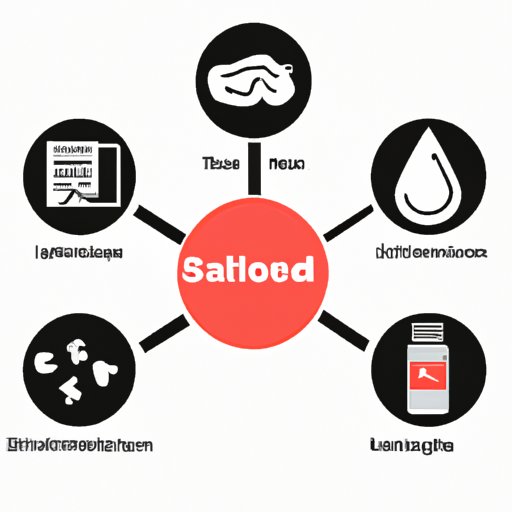Introduction: Explaining Aldosterone: What is this Hormone and How Does it Work?
Aldosterone is a steroid hormone primarily produced by the adrenal cortex, a part of the endocrine system. It is responsible for regulating electrolyte levels, particularly sodium and potassium, as well as regulating blood pressure. In addition, aldosterone affects kidney function and helps to maintain fluid balance in the body.
Aldosterone works by binding to mineralocorticoid receptors found in the epithelial cells of the distal convoluted tubules and collecting ducts of the nephron in the kidneys. When bound to these receptors, aldosterone stimulates the reabsorption of sodium and chloride ions from the renal tubules. This increases the osmolarity of the tubular fluid, allowing more water to be reabsorbed along with the sodium and chloride ions.
The Role of Aldosterone in Regulating Salt and Water Balance
How Aldosterone Regulates Salt and Water Reabsorption
When aldosterone binds to the mineralocorticoid receptors, it activates an enzyme called Na+/K+ ATPase, which pumps sodium ions out of the cell and potassium ions into the cell. This results in an accumulation of sodium ions in the extracellular space and an increase in intracellular potassium ion concentration. The increased concentration of sodium ions in the extracellular space causes water to be reabsorbed from the renal tubule into the bloodstream, resulting in an increase in blood volume and blood pressure.
In addition, aldosterone also stimulates the reabsorption of bicarbonate ions, leading to an increased concentration of bicarbonate in the blood. This helps to buffer any changes in acid-base balance, further contributing to the regulation of blood pressure.
Effects of Aldosterone on Sodium and Potassium Concentration
The increased reabsorption of sodium ions caused by aldosterone also has the effect of increasing the concentration of sodium ions in the bloodstream. This can lead to an increase in serum osmolarity, which in turn can stimulate thirst and cause the person to drink more fluids. The increased intake of fluids then further contributes to the regulation of blood pressure.
At the same time, the increased reabsorption of potassium ions caused by aldosterone has the effect of decreasing the concentration of potassium ions in the bloodstream. This can lead to hypokalemia, or low potassium levels, which can have serious health implications if left untreated.
How Does Aldosterone Affect Blood Pressure?
Relationship between Aldosterone and Blood Pressure
The primary role of aldosterone is to regulate blood pressure by controlling the amount of sodium and water in the body. When aldosterone is released, it increases the reabsorption of sodium and chloride ions from the renal tubules, resulting in increased blood volume and increased blood pressure. However, when aldosterone is not released, there is decreased reabsorption of sodium and chloride ions, resulting in decreased blood volume and decreased blood pressure.
In addition, aldosterone also helps to maintain the body’s acid-base balance by stimulating the reabsorption of bicarbonate ions in the renal tubules. This helps to buffer any changes in pH, further contributing to the regulation of blood pressure.
Understanding Aldosterone’s Mechanism of Action
Aldosterone binds to mineralocorticoid receptors located on the epithelial cells of the distal convoluted tubules and collecting ducts of the nephron in the kidneys. When bound to these receptors, aldosterone increases the activity of the enzyme Na+/K+ ATPase, which pumps sodium ions out of the cell and potassium ions into the cell. This results in an accumulation of sodium ions in the extracellular space and an increase in intracellular potassium ion concentration.
The increased concentration of sodium ions in the extracellular space causes water to be reabsorbed from the renal tubule into the bloodstream, resulting in an increase in blood volume and blood pressure. At the same time, the increased reabsorption of potassium ions causes a decrease in the concentration of potassium ions in the bloodstream, leading to hypokalemia.

Effects of Aldosterone on Kidney Function
How Aldosterone Influences Kidney Function
Aldosterone plays an important role in regulating kidney function. It increases the reabsorption of sodium and chloride ions from the renal tubules, resulting in increased blood volume and increased blood pressure. In addition, aldosterone also stimulates the reabsorption of bicarbonate ions, which helps to buffer any changes in acid-base balance.
Aldosterone also helps to maintain electrolyte balance by increasing the reabsorption of potassium ions from the renal tubules. This leads to a decrease in the concentration of potassium ions in the bloodstream, which can lead to hypokalemia if left untreated.
Understanding the Clinical Implications of Aldosterone’s Actions
The clinical implications of aldosterone’s actions are far reaching. Abnormal levels of aldosterone can lead to hypertension, hypokalemia, and other electrolyte imbalances. In addition, aldosterone can also affect kidney function, leading to an increased risk of kidney disease. Thus, it is important to monitor aldosterone levels in order to ensure proper functioning of the body’s systems.
Conclusion
Aldosterone is an important hormone that plays a key role in regulating electrolyte balance, blood pressure, and kidney function. It works by binding to mineralocorticoid receptors located on the epithelial cells of the distal convoluted tubules and collecting ducts of the nephron in the kidneys. When bound to these receptors, aldosterone increases the activity of the enzyme Na+/K+ ATPase, which pumps sodium ions out of the cell and potassium ions into the cell. This results in an accumulation of sodium ions in the extracellular space, causing water to be reabsorbed from the renal tubule into the bloodstream, resulting in an increase in blood volume and blood pressure.
Abnormal levels of aldosterone can lead to hypertension, hypokalemia, and other electrolyte imbalances. Thus, it is important to monitor aldosterone levels in order to ensure proper functioning of the body’s systems.
(Note: Is this article not meeting your expectations? Do you have knowledge or insights to share? Unlock new opportunities and expand your reach by joining our authors team. Click Registration to join us and share your expertise with our readers.)
